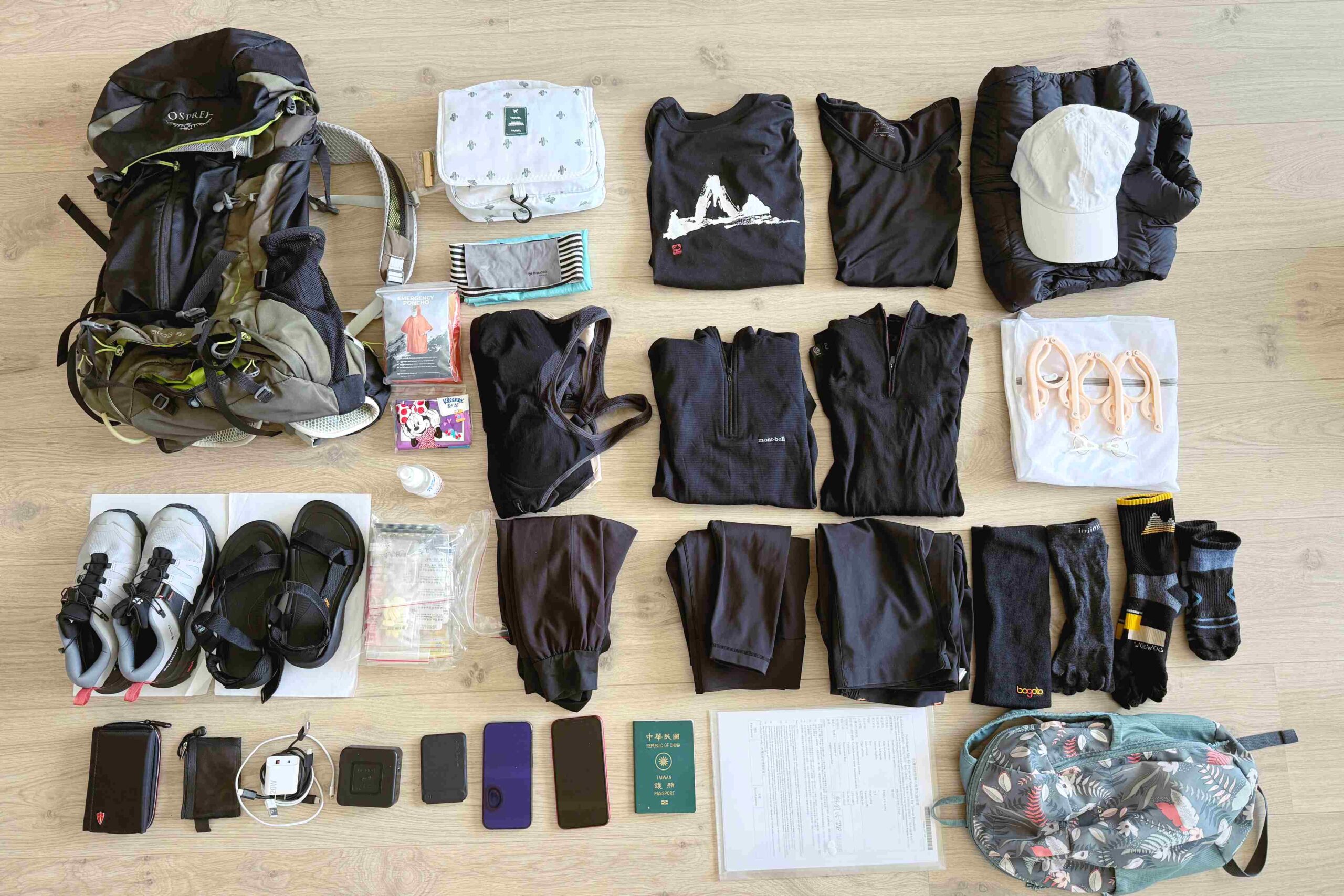When I was 23, I came across a quote in a travel magazine that stuck with me: "Three sets of clothes can get you through a week, and if you can make it a week, you can make it a month!" That single sentence changed the way I travel. After purchasing my very first Osprey 36L backpack, I became a backpacker for life. With that one backpack, I’ve walked the cobbled paths of Southern Europe, endured the scorching heat of West Asia and North Africa, and stayed alert through the unpredictability of South America. I completely fell in love with the freedom and flexibility that minimalist travel brings.
This trip — the Shikoku Pilgrimage in Japan — was yet another challenge in packing and preparation. From April to May, the temperature varies greatly: chilly mornings and evenings around 6°C, and daytime highs reaching 25°C. So, clothing needed to provide both warmth and breathability. Since I’d be walking 15 to 30 kilometers a day while constantly changing accommodation, my top priorities when choosing gear were lightweight and functional.
Below is a summary of my packing insights and gear list — perfect for anyone planning a long-distance hike in Japan during spring or autumn, or traveling to dry, cool climates.

Contents
。Basic Principles
01|Weight Control
Keep your backpack’s total weight under one-tenth of your body weight, ideally no more than 7 kg. Since I weigh around 47 kg, staying within that ratio was nearly impossible — but I still managed to keep my pack at 6.6 kg when I set off. After walking for 45 days, I can confidently say this weight was manageable, even for a petite woman.
02|Layering System
I followed the principle of wear one, carry one — wearing one set of clothes and carrying one spare — and relied on mid-layers and a good outer shell for warmth and flexibility.
03|Odor-Resistant & Quick-Dry Materials
Merino wool and odor-resistant fabrics from reputable outdoor brands were my go-to choices for keeping fresh and dry during the long journey.
。Backpack
01|30–38L Hiking Backpack
I used a 36L lightweight hiking backpack from Osprey, featuring a 3D mesh back panel that provides excellent ventilation and support. I highly recommend buying your backpack in-store rather than online — visiting an outdoor gear shop allows staff to help adjust the fit and weight distribution, which can significantly reduce strain during long hikes.
02|Rain Cover
Absolutely essential! Not only does it protect your pack from dirt and dust, but it also keeps your clothes, electronics, and nōkyōchō (temple stamp book) dry on rainy days.
。Important Documents & Essentials
01|Passport
02|Wallet
03|Cash & Credit Cards
04|Printed Itinerary: A digital version is usually sufficient, but having a hard copy can come in handy in areas with limited connectivity.
。Clothing Checklist
01|Tops – Prioritize moisture-wicking, odor-resistant, and quick-drying fabrics.
Short-Sleeved Shirt – Montbell wickron® T-shirt: Breathable and quick-drying; works as both a daytime shirt and sleepwear.
Long-Sleeved Thermal Base Layer – Montbell Zeoline M.W.: Warm, breathable, odor-resistant; dries overnight.
Wool Long Sleeve Top – Decathlon FORCLAZ Merino Zip Shirt: Great breathability, warmth, and odor control. Best dried near a dehumidifier or in a well-ventilated area.
02|Outerwear – For layering in cold weather or mountain climates.
Mid-Layer Fleece – Decathlon QUECHUA Hiking Fleece: Warm and breathable, ideal for layering.
Down Vest – LATIV Ultra-Light Down Vest: Wind-resistant and cozy — great for cooler, windy conditions.
03|Pants – Durable and breathable; essential for rough trails.
COHIKE Summer Hiking Pants: Quick-drying, breathable, abrasion-resistant.
COHIKE Winter Hiking Pants: Warm, fast-drying, and tough against wear.
Regular Athletic Pants: Doubles as loungewear or sleepwear.
04|Underwear – Must be quick-drying and odor-resistant.
Decathlon FORCLAZ Merino Sports Bra x2: Anti-odor, dries overnight.
Decathlon FORCLAZ Merino Underwear x2: Same qualities as above — minimal, functional, and travel-friendly.
05|Socks – Toe socks are highly recommended to prevent blisters.
WOAWOA Wool Toe Socks: Warm, supportive, and great for foot comfort.
Injinji Merino Wool Liner Socks: My go-to for about 2/3 of the journey — quicker drying and lighter support.
Regular Sports Socks: Used indoors or for rest days.
06|Footwear – Grip and comfort are key.
Main Shoes – SALOMON Ultra 4: Excellent traction and durability with Gore-Tex waterproofing. Great for wide feet.
Light Sandals – TEVA Hurricane XLT2: Perfect for airing out your feet during breaks; comfortable, sturdy, and grippy.
07|Knee Recovery Sleeves
I skipped wearing knee braces while walking to stay breathable, but I wore Bogoto knee sleeves before bed each night. They significantly reduced soreness by morning!
。Electronics
01|Two Smartphones
Much of the Shikoku Pilgrimage route passes through rural and mountainous areas where services and stores are limited. Bringing a backup phone is a smart move in case of emergency or technical issues.
02|Power Bank
03|Charging Adapter & Cables
。Toiletries & Medications
01|Skincare & Sunscreen
Since I carried my backpack onto the plane, I packed all liquids in containers under 100 ml. Don’t worry too much about running out — Japan has plenty of convenience stores and drugstores along the way for easy restocking. I relied on the toiletries provided by hostels and guesthouses for showering needs.
02|Medications
Medication needs vary by person. During my trip, Japan was experiencing outbreaks of influenza and norovirus-related stomach flu, so I brought: General cold medicine, stomach medication, anti-diarrheal, tamiflu (antiviral). All of these can be obtained in one go from a travel medicine clinic before departure.
List of Travel Medicine Clinics in Taiwan
03|Alcohol Spray or Wipes
Japan is generally very hygienic, but public toilets in rural areas and temples may lack soap. Bring your own hand sanitizer or alcohol wipes — how comfortable you are without them is a personal choice.
。Other Essentials
01|Small Day Bag: Can be worn as a front pouch to carry essentials like your wallet, phone, water bottle, and nōkyōchō (temple stamp book).
02|Bear Bell or Small Bell: Helps keep a safe distance from wildlife by alerting animals to your presence.
03|Lens Cloth: Useful not only for cleaning glasses but also for wiping your phone camera lens.
04|Lightweight Raincoat
05|Headscarf or Buff
06|Hat
07|Laundry Bag & Lightweight Hanger
